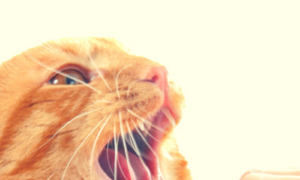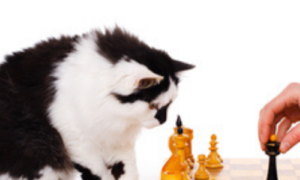By Elijah Merrill for The Daily Cat

Cat agility competitions are helping to shatter the stereotype of cats as untrainable, nap-happy slackers. Wondering if your cat has what it takes to be training in this increasingly popular sport? For those who are interested, getting started is fairly simple.
Find a Motivating Object
Cats don’t run the obstacle course just because it’s there. They need the proverbial carrot to lead them around. Popular items are toys, feathers or laser pointers, but knowing your cat’s quirks can yield great results. As examples, one of the fastest champions, Ursa Corynne, is motivated by chasing after a drinking straw, while Sir Linus, a Supreme Grand Champion in cat agility competitions, traverses each obstacle for the reward of a kiss from his owner, Vivian Frawley. Frawley is also a big proponent of clicker training: “Cats are very responsive to this. It allows you to apply operant conditioning to shape the behavior that is desired.” Lastly, don’t use an actual carrot, since food is forbidden as a lure during competition.
Know the Rules
“Typical course obstacles include a ladder that the cats step through, tunnels, fence jumps, cones or poles to weave through, and hoop jumps,” says Susan Lee, a cat agility trainer from Michigan. “An agility official oversees the run, times it and scores the faults. A fault is a refusal to do an obstacle. A slower run with no faults may place above a faster run with one fault.”
Practice at Home
“To start, sit in your favorite chair and drag a toy for your cat to follow. Then, add a pillow for them to jump over,” says Jill Archibald, agility coordinator for The Cat Fanciers’ Association. Official obstacle courses are expensive, but makeshift ones are easy to create. “A box with two open ends becomes a tunnel; a pillow becomes a jump; three one-liter bottles become weave poles; a toy hoop propped up becomes a hoop jump,” says Archibald.
Start Young
Although there are exceptions, most trainers agree that kittens or young cats perform and respond to training the best, as do neuters or spays. “Adult males or females are usually handicapped by their hormones,” says Archibald. “They are much more interested in finding each other than in doing agility!”
Get Your Cat Used to Crowds
“Training your cat to navigate obstacles is not enough,” says Archibald. “You must also train them to be comfortable in a large, noisy venue with unusual sights and sounds because almost all competitions are held at a cat show.” While it’s true that cats with outgoing, friendly dispositions are best suited to this, recluses can also succeed. Archibald recommends a steady diet of social exercise. “Go to a cat show without agility first, and enter the cat in the Household Pet class,” she says, to get it used to the sights and sounds of shows. “Otherwise, encourage people who visit you to play with the cat. Leave the TV on or the radio. They need to become used to unusual noises.”
Lastly, Have Fun!
Experts agree that the best recipe for success is the special bond that is created through all the practice (play) with your cat. “People underestimate what cats are willing to do once you have the kind of relationship with them that makes them feel safe and excited to do new things,” says Archibald.
Elijah Merrill is a freelance writer and frequent contributor to The Daily Cat. His work has appeared in The New York Times
Magazine and Discover.





